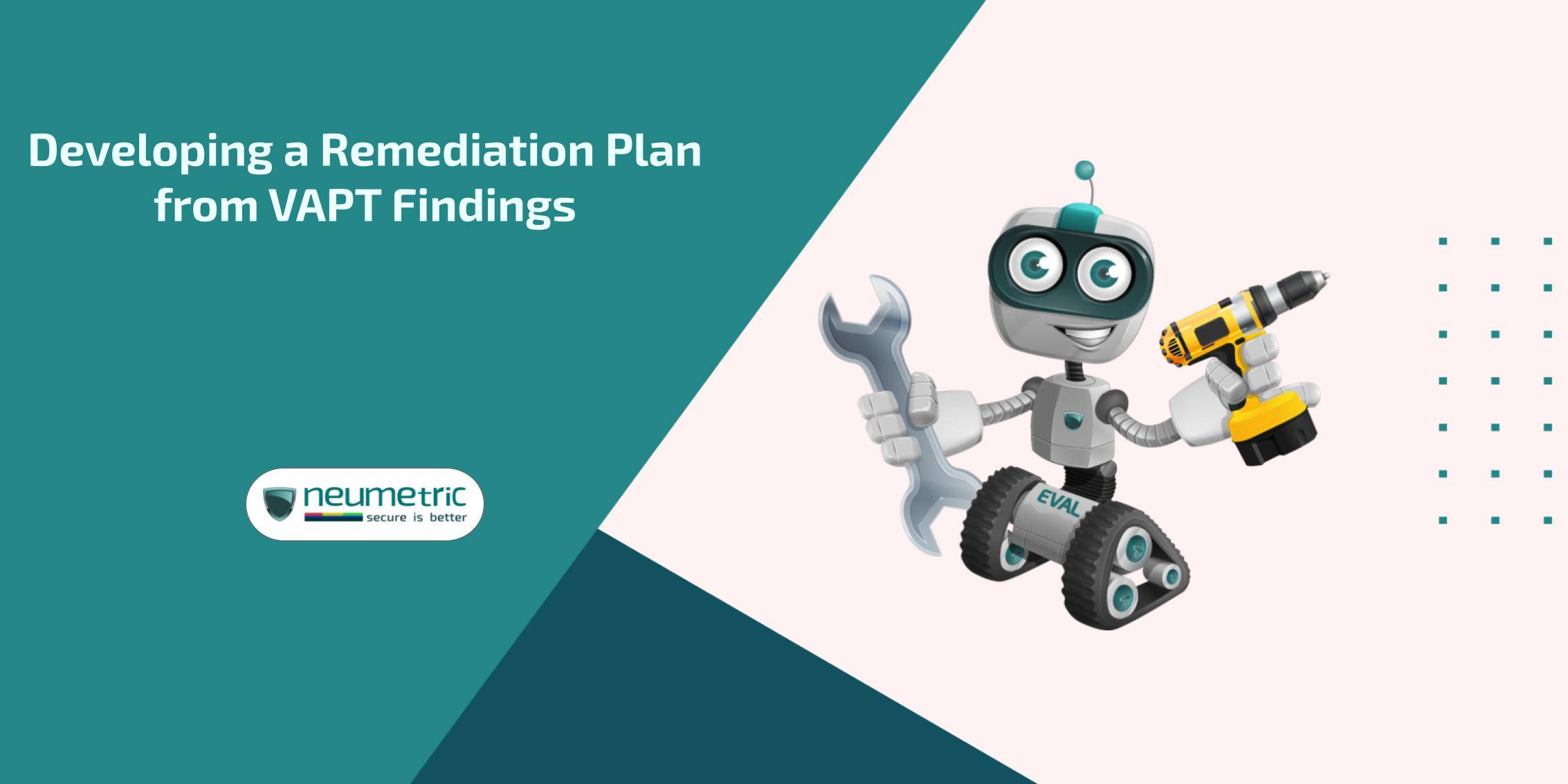Table of Contents
ToggleDeveloping a remediation plan from VAPT findings
Introduction
In the ever-evolving landscape of cybersecurity, organisations are increasingly turning to Vulnerability Assessment & Penetration Testing [VAPT] to bolster their defence mechanisms. VAPT is a comprehensive cybersecurity practice that involves systematically identifying vulnerabilities in an organisation’s digital infrastructure & simulating real-world cyberattacks to assess the effectiveness of existing security measures.
VAPT findings serve as a roadmap for organisations to enhance their cybersecurity posture. These findings highlight potential weaknesses, misconfigurations & vulnerabilities that malicious actors could exploit. The significance lies not only in identifying these issues but also in developing an effective remediation plan to address & mitigate the risks associated with them.
While VAPT is instrumental in uncovering vulnerabilities, it is the subsequent development & implementation of a remediation plan that truly fortifies an organisation’s security. A remediation plan outlines actionable steps to address identified vulnerabilities, ensuring a proactive approach to cybersecurity that goes beyond mere identification to mitigation & continuous improvement.
Understanding VAPT findings
Vulnerability Assessment & Penetration Testing [VAPT] constitute a crucial aspect of cybersecurity, providing organisations with valuable insights into the strengths & weaknesses of their digital infrastructure.
Types of findings
- Vulnerabilities: Vulnerabilities represent potential entry points for cyber threats. These can range from software vulnerabilities & misconfigurations to unpatched systems. Identifying vulnerabilities is essential for preemptively addressing potential points of exploitation.
- Weaknesses: While not necessarily vulnerabilities, weaknesses highlight areas that may pose risks to the overall security posture. Examples include inadequate access controls & incomplete logging practices. Addressing weaknesses enhances the organisation’s resilience against potential threats.
- Exposure of sensitive information: VAPT often uncovers instances where sensitive information may be at risk. This can include scenarios such as unprotected databases & unencrypted data transmission, emphasising the importance of securing confidential data.
Prioritising findings based on severity
- Critical findings: Critical findings demand immediate attention due to their potential to cause severe harm. These vulnerabilities could lead to unauthorised access, data breaches or system compromise. Swift mitigation is imperative to minimise risks.
- High-priority findings: High-priority findings, while not as critical as the former, still require urgent remediation. These vulnerabilities may pose significant risks & should be addressed promptly to fortify the security posture.
- Medium & low-priority findings: Medium & low-priority findings are less critical but still demand attention. Remediation efforts should be planned based on a prioritised schedule, considering the organisation’s risk tolerance & resource allocation.
Communicating VAPT findings effectively
- Reporting structure: VAPT reports should include an executive summary for non-technical stakeholders & detailed technical information for IT & security teams. This dual approach ensures that all stakeholders can grasp the findings & the necessary remediation steps.
- Actionable recommendations: The report should provide clear guidance on prioritising critical findings & offer concrete steps for remediation. These actionable recommendations empower organisations to translate VAPT findings into effective security measures.
As organisations embark on the journey of understanding VAPT findings, they gain not only a comprehensive view of vulnerabilities & weaknesses but also the strategic insights needed to fortify their digital defences.
Building a remediation team
Developing an effective remediation plan requires the collaboration of skilled professionals from various domains within an organisation. In this section, we explore the process of building a robust remediation team, ensuring that the right expertise is engaged to address vulnerabilities identified through Vulnerability Assessment & Penetration Testing [VAPT].
Involving key stakeholders
- Security team
Role: The core of the remediation team, responsible for implementing security measures.
Tasks: Patching vulnerabilities, configuring security settings & ensuring compliance with security policies.
- IT department
Role: Critical for implementing technical changes & system updates.
Tasks: Collaborating with the security team to apply patches, update systems & address configuration weaknesses.
- Development teams
Role: Essential for fixing vulnerabilities in applications & software.
Tasks: Collaborating with the security team to address code-related vulnerabilities, implementing secure coding practices.
Collaborating with IT & development teams
- Communication channels: Facilitating open communication between security, IT & development teams to ensure a shared understanding of findings & remediation strategies.
- Cross-functional training: Training IT & development teams on security best practices & providing security teams with insights into the development process.
- Joint remediation workshops: Conducting joint workshops to address specific vulnerabilities, fostering collaboration & sharing expertise across teams.
Assigning responsibilities & deadlines
- Task allocation:
Clear responsibilities: Assigning specific responsibilities to team members based on their expertise.
Task prioritisation: Prioritising tasks based on severity & criticality.
- Setting deadlines:
Time-bound remediation: Establishing realistic timelines for addressing vulnerabilities.
Continuous monitoring: Implementing continuous monitoring to track progress against deadlines.
Continuous communication & feedback
- Regular updates
Status updates: Providing regular updates on remediation progress to all stakeholders.
Transparency: Fostering a transparent environment where challenges & successes are communicated openly.
- Feedback mechanisms
Encouraging feedback: Creating avenues for team members to provide feedback on the remediation process.
Iterative improvement: Using feedback to iterate & improve the remediation approach.
Building a robust remediation team involves not only selecting the right individuals but also fostering a collaborative & communicative environment. By aligning the efforts of security, IT & development teams, organisations can efficiently address vulnerabilities & strengthen their overall cybersecurity posture.
Creating an actionable remediation plan
Translating VAPT findings into a comprehensive & actionable remediation plan is pivotal for organisations looking to fortify their cybersecurity defences. This section outlines the key steps involved in crafting a remediation plan that is not only strategic but also executable.
Setting clear objectives
- Defining security objectives
Identifying goals: Clearly defining the overall security objectives to be achieved through the remediation plan.
Alignment with business goals: Ensuring that security objectives align with broader organisational objectives.
- Prioritising remediation goals
Critical vs. non-critical objectives: Distinguishing between critical objectives requiring immediate attention & those with a lower priority.
Risk-based prioritisation: Prioritising goals based on potential risks to the organisation.
Defining milestones & timelines
- Breaking down remediation tasks
Granular task breakdown: Breaking down remediation goals into smaller, manageable tasks.
Dependencies & interconnections: Identifying dependencies between tasks & addressing them accordingly.
- Establishing timelines
Realistic timelines: Setting achievable timelines for each task, considering the complexity & urgency.
Continuous monitoring: Implementing mechanisms for continuous monitoring to track progress against timelines.
Allocating resources effectively
- Resource identification
Identifying required resources: Determining the human, financial & technological resources necessary for successful remediation.
Skillset requirements: Ensuring that the remediation team possesses the required skill sets.
- Budget allocation: Allocating a budget for remediation activities, taking into account potential costs associated with tools, training & external support.
Implementing remediation measures
- Patching & updating systems
Automated patching: Leveraging automated tools for timely patching of vulnerabilities.
Testing procedures: Implementing testing procedures to ensure patches do not disrupt system functionality.
- Code fixes & development changes
Secure coding practices: Incorporating secure coding practices to address vulnerabilities in software & applications.
Collaboration with development teams: Ensuring close collaboration between security & development teams for effective code fixes.
Continuous monitoring & validation
- Implementing continuous security checks
Ongoing monitoring: Incorporating continuous security checks to identify new vulnerabilities.
Automation & Artificial Intelligence [AI] integration: Leveraging automation & artificial intelligence for real-time threat detection.
- Validating effectiveness of remediation measures
Penetration testing verification: Conducting follow-up penetration tests to validate the effectiveness of remediation.
Feedback mechanisms: Establishing feedback mechanisms to capture insights from ongoing monitoring & user experiences.
Iterative testing & improvement
- Learnings from past remediation efforts
Post-implementation evaluation: Evaluating the effectiveness of remediation measures post-implementation.
Identifying patterns: Identifying recurring vulnerabilities or challenges for future improvement.
- Adapting to evolving threat landscapes
Staying informed: Remaining vigilant to emerging threats & adjusting the remediation plan accordingly.
Continuous improvement: Cultivating a culture of continuous improvement in cybersecurity practices.
Creating an actionable remediation plan requires meticulous planning & a proactive approach. By setting clear objectives, defining milestones, allocating resources effectively, implementing remediation measures & continuously monitoring & improving, organisations can navigate the complexities of cybersecurity with resilience & agility.
Configuration adjustments & policy updates
- Adapting network & system configurations
Addressing configuration weaknesses: Making necessary adjustments to network & system configurations to mitigate identified weaknesses.
Regular audits: Conducting regular audits to ensure configurations remain secure over time.
- Enhancing security policies
Policy Updates: Updating & enhancing security policies to reflect the latest threat landscape.
Employee Training: Ensuring employees are aware of & adhere to updated security policies through ongoing training.
Feedback mechanisms & communication strategies
- Internal communication
Feedback loops: Establishing feedback loops within the remediation team for continuous improvement.
Regular progress updates: Communicating progress updates & addressing any roadblocks promptly.
- External communication
Stakeholder communication: Keeping stakeholders informed about the progress of remediation efforts.
Transparent reporting: Providing transparent & clear reports on the status of security improvements.
By implementing these remediation measures, organisations can actively address vulnerabilities & create a more resilient cybersecurity posture.
Conclusion
As we conclude this exploration of leveraging VAPT for competitive advantage in business, it is evident that proactive cybersecurity measures are foundational to success in the digital era. The future holds the promise of even more advanced VAPT methodologies, artificial intelligence integration & collaborative industry efforts to stay ahead of emerging threats.
In embracing VAPT as a strategic imperative, businesses can not only safeguard their digital assets but also position themselves as leaders in the ever-evolving landscape of cybersecurity. By prioritising continuous improvement, adapting to emerging trends & fostering collaboration, organisations can build a resilient foundation for sustained success in the dynamic & interconnected digital realm.
FAQ
How can businesses choose the right VAPT approach that suits their specific needs?
Selecting the right VAPT approach involves assessing the organisation’s needs, risk tolerance & available resources. It’s about finding a tailored solution that aligns with the business’s unique requirements, ensuring effective cybersecurity without unnecessary complexities.
How can businesses balance the speed of implementing remediation measures with ensuring accuracy?
Striking a balance between speed & accuracy involves prioritising critical vulnerabilities for immediate attention while ensuring thorough testing protocols are followed. This approach allows organisations to implement remediation measures quickly without compromising on effectiveness.
What role does collaboration play in addressing cybersecurity challenges during remediation?
Collaboration is key in addressing cybersecurity challenges during remediation. Fostering communication between security, IT & development teams ensures a holistic & coordinated approach, overcoming silos & streamlining the remediation process.
How can businesses measure the success of their remediation efforts & what metrics should they consider?
Measuring the success of remediation efforts involves defining key performance indicators (KPIs) aligned with security objectives. Metrics such as the number of vulnerabilities addressed, response time & ongoing compliance can serve as valuable indicators of remediation success.
In a rapidly evolving threat landscape, how can organisations future-proof their security measures?
To future-proof security measures, organisations should integrate threat intelligence into continuous monitoring, stay informed about emerging threats & proactively implement measures based on insights gained from monitoring.





